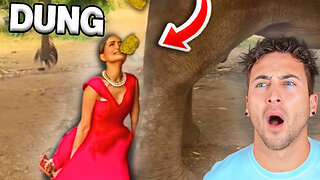Premium Only Content

10 Awesome Extinct Animals You'll Probably Never Heard Of
Patreon: https://www.patreon.com/factknowledge
Animal extinctions may be caused by natural occurrences such as climatic heating or cooling or changes in sea levels. In more modern times, however, human activity has been to blame. Habitat destruction as farming land expands and forests are cut-down is the main cause of modern extinctions, along with pollution, the introduction of alien species, and over fishing or hunting. Increasingly, however, climate change is thought to be driving extinctions. Now lets see the top 10 most famous extinct animalsnumber 10. West African Black Rhinoceros
The West African Black Rhinoceros was found in several countries towards the southeast region of Africa. Measuring 3-3.8 metres long and 1.4-1.7 metres in height, this rhino would have weighed 800-1,300 kg. It had two horns, one measuring 0.5-1.3 metres and the other between 2-55cm. Their diet included leafy plants and shoots. Some believe their horns had medicinal properties – though this had no grounding in scientific fact – which lead to heavy poaching. In the 1930’s preservation action was taken to protect the species, but the numbers continued to decline. The last West African Black Rhino was seen in Cameroon in 2006. It was declared officially extinct in 2011. number 9. Baiji White Dolphin
Baiji White Dolphin, also called the Chinese River Dolphin, can only be found in the Yangtze River in China. These mammals could grow to eight feet long and weigh up to a quarter of a ton. They relied on echolocation to navigate and hunt for pray due to their tiny eyes and very poor eyesight. Living in the Yangtze for 20 million years, their numbers declined drastically from the 1950s onwards. As China industrialised, the river was used for fishing, transportation and hydroelectricity which had a huge effect on the mammals. Although not officially recorded as extinct, no one has seen a Yangtze River Dolphin since 2002.number 8. Pyrenean Ibex
One of four subspecies of the Spanish Ibex or Iberian Goat that was found in the Iberian Peninsula. The Ibex would grow to a height of 60-76cm at the shoulder and weigh 24-80 kg and fed mainly on grasses and herbs. They were thought to have numbered 50,000 historically, but by the early 1900s its numbers had fallen to fewer than 100. The exact cause of the Pyrenean Ibex’s extinction is unknown; scientists believe factors included poaching and the inability to compete with other mammals for food and habitat. The last Pyrenean Ibex was killed by a falling tree in northern Spain in 2000.number 7. Passenger Pigeon
Native to North America, the Passenger or Wild Pigeon has been extinct since the early 20th century. It is estimated that between 3 and 5 billion Passenger Pigeons inhabited the US when Europeans arrived in North America, but their settlement led to mass deforestation resulting in habitat loss and a reduction in the bird population. By the 19th century pigeon meat was commercialized as a cheap food for the poor, which resulted in hunting on a massive scale. The Passenger Pigeon died out in the wild by around 1900, with the last known individual dying in captivity in 1914.number 6. Tasmanian Tiger
Native to Australia, Tasmania and New Guinea, the Tasmanian Tiger was a large carnivorous marsupial. Not related to tigers, the creature had the appearance of a medium-to-large-size dog (it weighed 30kg with a nose to tail length of almost 2 metres) but dark stripes gave it a tiger-like appearance. It is believed to have been hunted to extinction – this was encouraged by bounties – but human encroachment into its habitat, the introduction of dogs and disease could also have contributed. The last wild Tasmanian Tiger was killed between 1910 and 1920, with the last captive one dying in Hobart Zoo, Tasmania in 1936.number 5. Stellers Sea Cow
Named after George Steller, a naturalist who discovered the creature in 1741, Stellers Sea Cow was a large herbivorous mammal. It is believed that Stellers Sea Cow which grew to at least 8-9 metres and weighed around 8-10 tons, inhabited the Near Islands, southwest of Alaska and the Commander Islands in the Bering Sea. It is believed that the mammal was tame and spent most of its time eating kelp; this, and the fact that it was unable to submerge its enormous body, is possibly what made it vulnerable to human hunters. Within 27 years of discovery by Europeans, Steller’s Sea Cow was hunted to extinctionnumber
#geography #extinct #extinction #facts
-
 LIVE
LIVE
Misfit Electronic Gaming
6 hours ago"LIVE" "Blind Descent' +"Dollhouse of Dead" Playtest 10 Followers till we hit 1000! We CAN do this!
54 watching -
 21:53
21:53
Glenn Greenwald
5 hours agoMichael Tracey on the Street: What Do People Think of the Epstein Case?
82.6K52 -
 LIVE
LIVE
megimu32
2 hours agoOTS: Board Games Gone Wild! The Loud, Weird & Chaotic Games That Raised Us
127 watching -
 LIVE
LIVE
DamnDanieI
2 hours agoKill First, Loot Later – OTG Live
250 watching -
 56:41
56:41
Donald Trump Jr.
6 hours agoLies, Leaks, and Lawfare: Censorship Corruption Exposed | TRIGGERED Ep.263
112K107 -
 LIVE
LIVE
Precision Rifle Network
4 hours agoS4E25 Guns & Grub - Rex Is Back, I shot the 6.5PRC finally...
32 watching -
 LIVE
LIVE
rhywyn
1 hour agoうつ
29 watching -
 LIVE
LIVE
RyuMuramasa✧
3 hours agoNEW Everdark Sovereign | Elden Ring Nightreign | LIVE Playthrough
33 watching -
 1:17:04
1:17:04
Nikko Ortiz
10 hours agoLive - News, Politics, Podcast And Naaah Im Playin We Chillen
1.99K -
 1:26:13
1:26:13
Mally_Mouse
5 hours agoLet's Hang!! -- P.O. Box & Chill!
9.71K